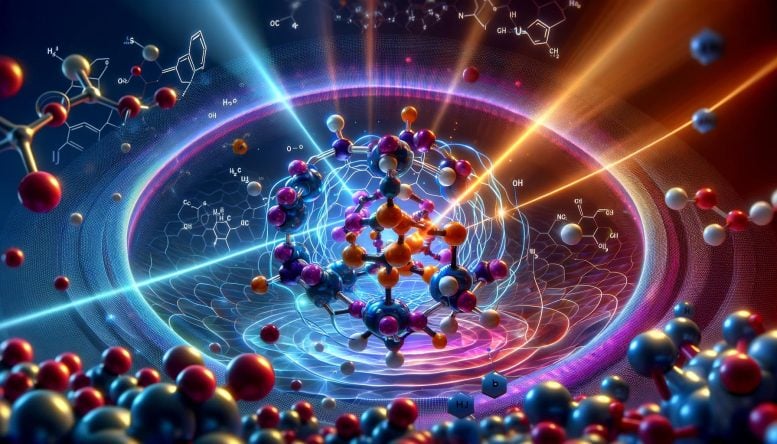
By ICFO-THE INSTITUTE OF PHOTONIC SCIENCES JUNE 11, 2024
Collected at: https://scitechdaily.com/molecules-in-motion-advanced-spectroscopy-captures-molecular-dynamics-in-real-time/
Researchers have developed a new method that uses attosecond core-level spectroscopy to capture molecular dynamics in real time.
The mechanisms behind chemical reactions are complex, involving many dynamic processes that affect both the electrons and the nuclei of the involved atoms. Frequently, the strongly coupled electron and nuclear dynamics trigger radiation-less relaxation processes known as conical intersections. These dynamics underpin many significant biological and chemical functions but are notoriously difficult to detect experimentally.
The challenge in studying these dynamics stems from the difficulty of tracing the nuclear and electronic motion simultaneously. Their dynamics are intertwined and occur on ultrafast timescales, which has made capturing the molecular dynamical evolution in real time a major challenge for both physicists and chemists in recent years.
Now, a team of researchers from ICFO has developed a powerful tool based on attosecond core-level spectroscopy to investigate molecular dynamics in real-time, successfully overcoming this challenge.
The team, led by ICREA Prof. Jens Biegert, includes ICFO researchers Dr. Stefano Severino, Dr. Maurizio Reduzzi, Dr. Adam Summers, Hung-Wei Sun, and Ying-Hao Chien, and Dr. Karl Michael Ziems and Prof. Stefanie Gräfe from the Friedrich-Schiller-Universität Jena, who provided theoretical support. Their findings were recently published in the journal Nature Photonics.

Artistic illustration portraying the ring-opening dynamics of the furan molecule. Credit: ICFO/ EllaMaru Studio
Study of Gas-Phase Furan
The researchers benchmarked their method tracing the evolution of gas-phase furan, an organic molecule made of carbon, hydrogen, and one oxygen arranged in a pentagonal geometry. Its cyclic structure gives this kind of species the name of chemical “ring”. The choice was not arbitrary, as furan is the prototypical system for the study of heterocyclic organic rings, the essential constituents of many different day-to-day products such as fuels, pharmaceuticals, or agrochemicals. Understanding their dynamics and relaxation processes is crucial.

Schematic illustration portraying the details of the entire ring-opening dynamics of furan. Credit: ICFO
Ring-Opening Dynamics of Furan
The team was able to time-resolve the details of the entire ring-opening dynamics of furan, that is, the fission of the bond between one carbon and the oxygen, which breaks its cyclic structure. To do it, they had to track the so-called conical intersections (CI), ultrafast gateways between different energy states that furan undertakes in its evolution towards ring-opening.
In their experiment, a light beam (the pump pulse) first excited the furan molecule. Then, an attosecond and a much weaker pulse (the probe) were used to monitor the pump-induced changes in the sample. After the initial photoexcitation, the three expected conical intersections were located in time by analyzing the changes in the absorption spectrum as a function of the delay between the pump and probe. The appearance and disappearance of absorption features, as well as their oscillatory behavior, provide signatures of the changes in the electronic state of furan.
They could see that the passage through the first CI transition generates a quantum superposition between the initial and final electronic states, which manifested in the form of quantum beats. This ultrafast phenomenon, which can only be explained using quantum theory, was extremely hard to identify in previous experiments. The second CI was in principle even more challenging to capture, as the final electronic state does not emit nor absorb photons (it is an optically dark state) and thus its detection through conventional methods is extremely demanding. Nevertheless, in this case, their platform performed the task as well as before.
After that, the ring-opening was supposed to occur and the team’s equipment was victorious again in its detection. The passage of the molecule from a closed to an open ring geometry implies a symmetry breaking that is imprinted in the absorption spectrum. The spectroscopic tool used by the researchers demonstrated to be extremely sensitive to the nuclear structure, and the ring-opening manifested itself as the appearance of new absorption peaks.
Finally, the molecule relaxed into the ground state (the lowest molecular orbital available) through the third conical intersection, whose transition was again accurately time-resolved.
Success of Attosecond Core-Level Absorption Spectroscopy
Biegert and his group have proposed and successfully demonstrated a new analytical methodology to unveil the complex process of molecular ring-opening in its native ultrafast timescale. The combined high temporal resolution and coherent energy spectrum of their cutting-edge technique allowed them not only to track the transitions of furan across conical intersections, but also to identify electronic and nuclear coherences, quantum beats, optically dark states, and symmetry changes, providing an extremely detailed picture of the whole relaxation process.
The power of attosecond core-level spectroscopy is not limited to this particular molecule but is a general tool designed to be employed with other species as well. Therefore, this new mechanism can bring to light the complex dynamics of relevant functions, such as the photoprotection mechanism of the DNA basis. Furthermore, the researchers identify the manipulation of efficient molecular reactions and energy relaxation dynamics as some of the most promising applications for their work.
Reference: “Attosecond core-level absorption spectroscopy reveals the electronic and nuclear dynamics of molecular ring opening” by S. Severino, K. M. Ziems, M. Reduzzi, A. Summers, H.-W. Sun, Y.-H. Chien, S. Gräfe and J. Biegert, 29 April 2024, Nature Photonics.
DOI: 10.1038/s41566-024-01436-9

Leave a Reply